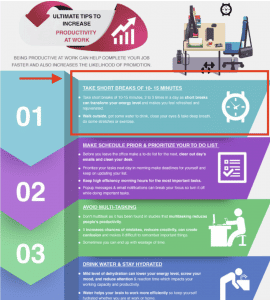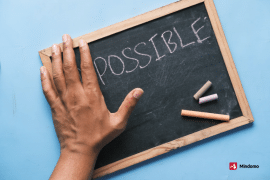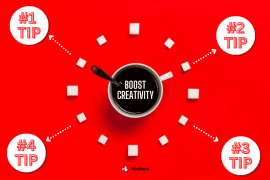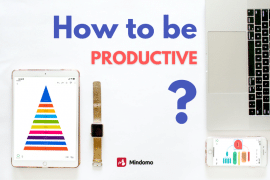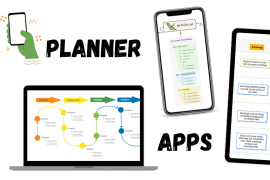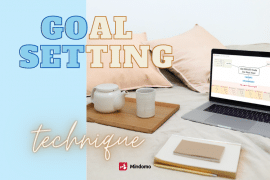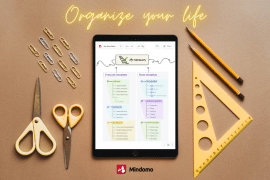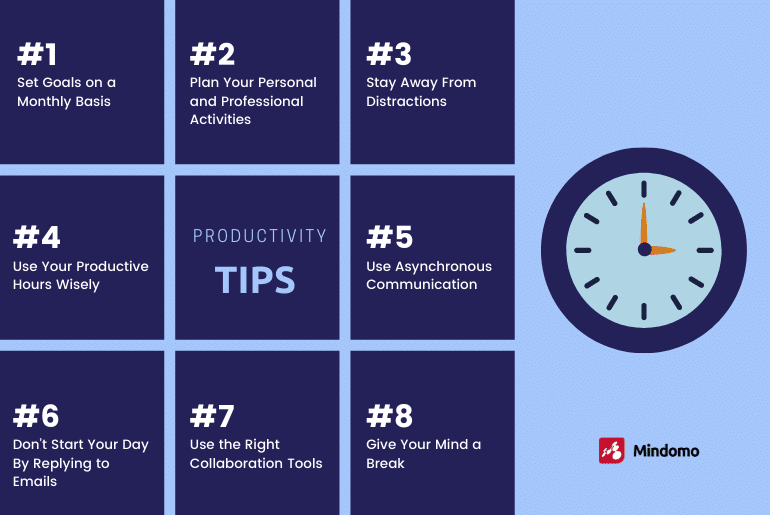
Depending on the type of work you do, being productive and remaining motivated throughout the day might be a challenging task.
It can definitely be achieved, as long as you follow some sort of routine that allows you to bring your best self at work.
In this post, we’re going to dive deep into being productive and making the most of your day by highlighting some important and useful tips.
These are the tips we’re taking you through:
- Set goals on a monthly basis
- Plan your personal and professional activities
- Stay away from distractions
- Use your productive hours wisely
- Use asynchronous communication
- Use the right collaboration tools
Plus a few more.
Without further ado, let’s get started!
Table of contents
Tip #1: Set Goals on a Monthly Basis
Tip #2: Plan Your Personal and Professional Activities
Tip #3: Stay Away From Distractions
Tip #4: Use Your Productive Hours Wisely
Tip #5: Use Asynchronous Communication
Tip #6: Don’t Start Your Day By Replying to Emails
Tip #7: Use the Right Collaboration Tools
Tip #8: Give Your Mind a Break
Tip #1: Set Goals on a Monthly Basis
In this section, we basically want to highlight the importance of goal setting in order to increase productivity, thus eliminating unproductive work.
Therefore, the first tip we want to share with you is to set goals on a monthly basis.
The reason I’m telling you to plan and set goals on a monthly basis is that upfront planning can have a truly positive impact on your work and personal life.
In other words, setting goals can significantly help you not only remain focused on what you want to achieve but also prioritize efficiently, thus saving you lots of time and energy.
When I speak of prioritization, I basically mean that proper planning can be helpful in terms of showing you what kind of work and tasks really matter and where you should be channeling your energy.
OK, you may think, but still what’s the most important advantage of setting goals?
Well instead of telling you, I’m going to use a graph that’s pretty self-explanatory and I think it says it all.
The graph comes from FinancesOnline and depicts the data found by a Harvard report.
Have a look:
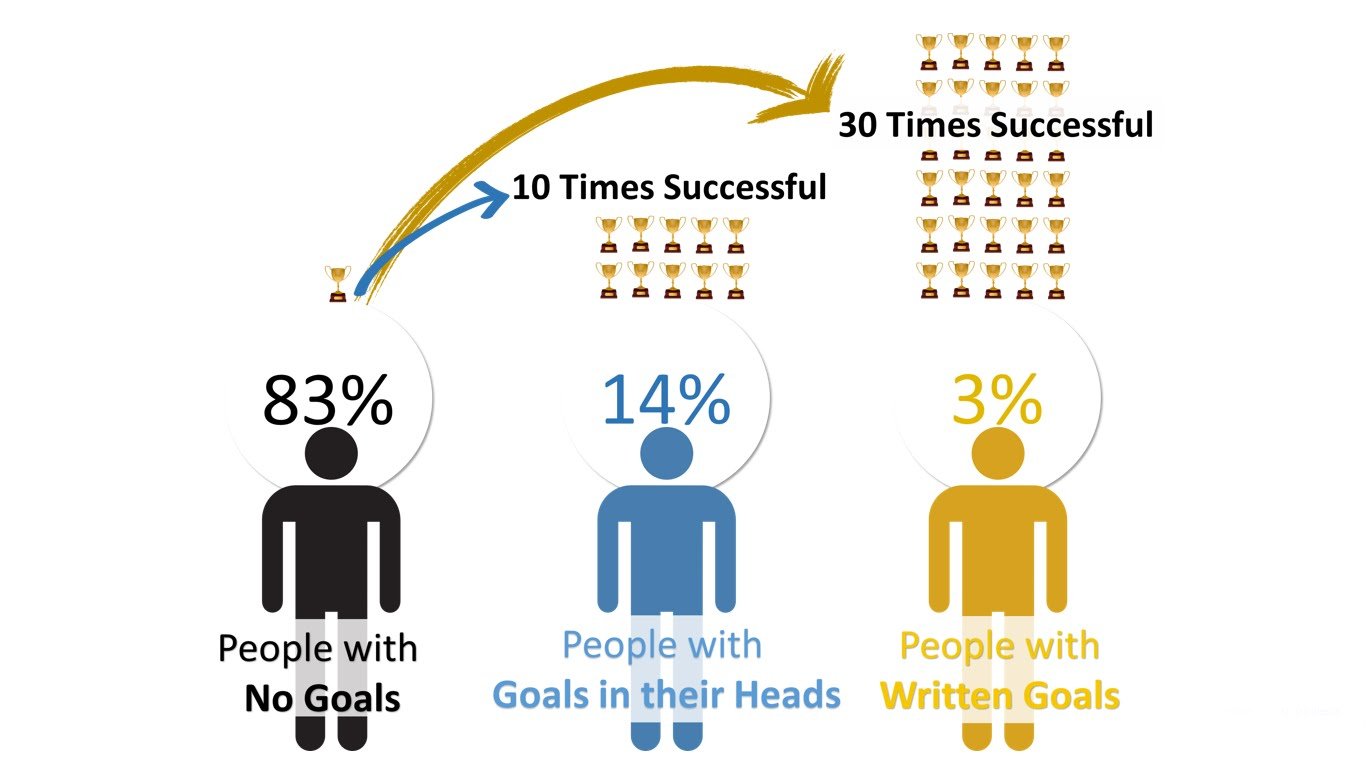
Image Source: FinancesOnline
What the graphic shows us is that people that have goals are generally far more successful than those who don’t.
An additional interesting point is that people that get their goals written down tend to be 30% more successful than people with no goals and also more successful than those who do have goals but keep them in their head instead of visualizing them.
Therefore, we understand that goal setting alongside visualization can be incredibly impactful in terms of success and productivity.
Author’s Tip: In the process of visualizing your goals, you might find it helpful to use a mind mapping tool that does exactly that. There are many mind mapping alternatives available, it’s important to compare them and choose the one that fits your needs.
Tip #2: Plan Your Personal and Professional Activities
Our second productivity tip is to do some planning in terms of your personal and professional activities.
Similar to what we’ve already discussed, here we’re getting deeper into planning your activities, both personal and professional.
As we’ve mentioned a little further up in this post, visualizing your goals — and in this case, your plans — can significantly help you increase your productivity.
The following quote summarizes the importance of proper planning in terms of actually getting the job done.
Have a look:
Image Source: Entrepreneur
Having a well-organized calendar works like a sort of path that you need to follow each day, thus facilitating your workflow of passing from one task to another.
Most importantly, it brings you closer to knowing what to do during your work hours without having to worry too much about getting the time to complete them all.
Moreover, adding your tasks to your calendar and being able to see the entirety of the things you need to do during a day means that you won’t have to put time or energy into figuring out your schedule while already working.
For example, if you have to make a number of phone calls or send out emails as part of your company’s PR outreach strategy, alongside doing research which demands your full attention, and you also have to go to the coffee shop, then you need to have these completely different types of tasks planned upfront.
Planning will save you valuable time and help you protect your energy levels.
Working from home is a demanding and often time-consuming process that requires tons of self-motivation and self-discipline.
You should try to do your best and avoid procrastination and endless multitasking.
Although multitasking isn’t always bad, it’s absolutely necessary to set some limits in terms of how often you switch between the different tasks you need to do.
The following two simple tips can help you plan your activities as well as keep some balance between your personal and professional activities:
- Limit the number of things you juggle at any given time to just two tasks.
- Use the “20-minute-rule”. Instead of constantly switching between tasks and activities, try to fully devote your attention to one task for a considerable amount of time before switching to the other.
Once more, I’d like to bring up the importance of visualizing your plans.
You could go for an old-time classic calendar or a virtual calendar that gives you the opportunity to take your planning to another level, for example by adding recurring tasks, etc.
Here’s how such a to-do list might look:
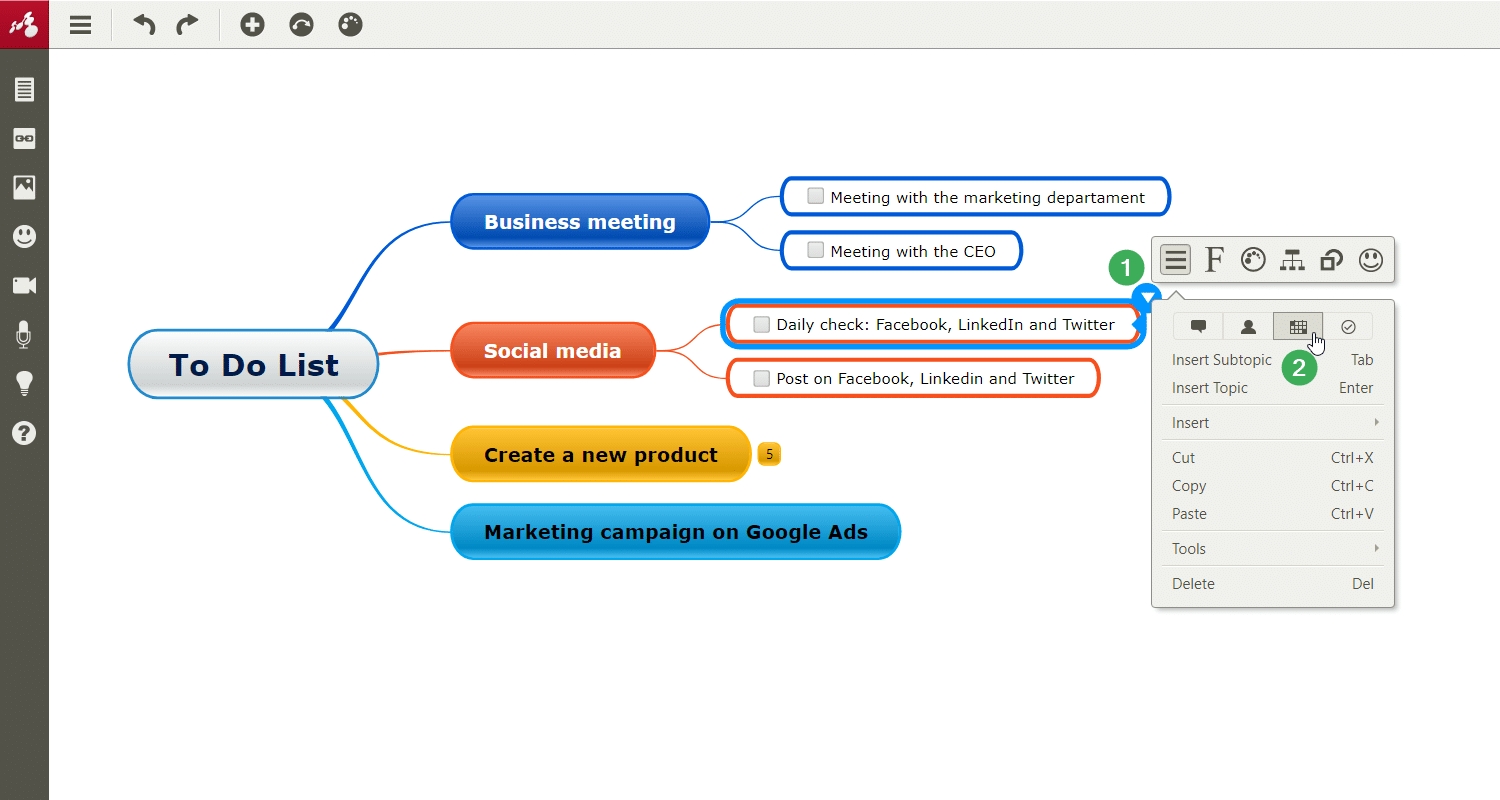
It’s easy on the eye and helps you keep track of your tasks and activities without stressing you out, using a mind map task list.
Tip #3: Stay Away From Distractions
A very useful productivity hack is to keep yourself away from distractions.
This basically means that you try to create for yourself a work environment that eliminates distractions and allows you to remain focused on your important tasks.
For example, avoid checking your cell phone every couple of minutes.
It might be helpful to keep it switched off or put it on mute and give yourself a few minutes with it every couple of hours or during your break only unless there’s an emergency.
However, you shouldn’t think of this as a mandatory rule that you need to follow no matter what, because this may have the exact opposite result.
Instead, you should think of the overall process of staying away from distractions – including your phone – as something that’ll greatly benefit you and allow your mind to act consciously and not multitask.
Before we dive any deeper, we’d like to bring to the table a fantastic quote from Nir Eyal’s book, Indistractable: How to Control Your Attention and Choose Your Life.
The quote goes as follows:
“Being indistractable means striving to do what you say you will do.
Indistractable people are as honest with themselves as they are with others.
If you care about your work, your family, and your physical and mental well-being, you must learn how to become indistractable.”
Eyal’s words might sound a bit harsh, but no one can doubt the fact that distractions might truly hurt someone’s health and might even lead to work burnout.
The good thing is that you can totally nail the “no distractions” approach.
You just need some self-discipline and proper planning.
Here’s a nice, simple graph that highlights some tips to stay away from distractions.
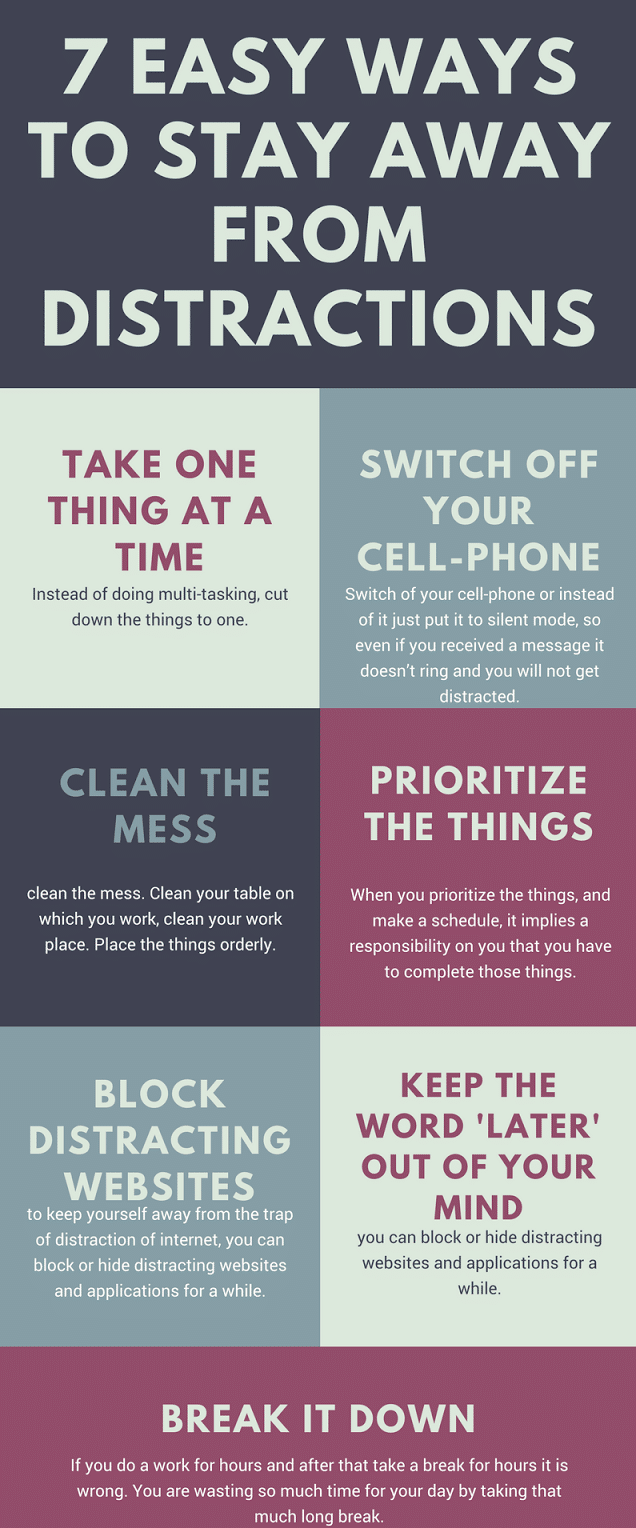
Image Source: Shut Dem All
As we’ve mentioned already, visualization can be extremely helpful.
For that reason, you could consider creating your own infographic and adding up all the tested tips and tricks you know are helpful for you and the way you work, in order to minimize distractions and be productive.
This can help you produce work of high quality while saving you some energy for the things that matter the most.
Tip #4: Use Your Productive Hours Wisely
Our fourth tip to you is to try to make the most out of your most productive hours of the day.
In other words, use your productive time of day wisely.
Daniel Pink’s book, When: The Scientific Secrets of Perfect Timing, supports the concept of perfect timing being one of the best tips in terms of doing your best work on a personal and professional level.
In other words, it’s about how performing the most appropriate task at the right and most appropriate time of the day can significantly improve your productivity and your work quality.
What’s essential to mention is that, setting some guidelines for yourself in terms of what you do and when you can help control and keep track of the way you spend your time and energy.
For example, if one of your day’s tasks is to brainstorm collaboratively for a new project, which of course requires a well-rested mind in order to explode with creativity, you should plan it properly.
This might mean that you’re saving the first hours of your working day in order to be in your best shape to not only communicate with your co-workers efficiently but also offer your sharpest ideas that usually come when you’re not thinking of a trillion other things.
The idea of thinking and taking advantage of so-called perfect timing can basically be one of your most powerful weapons in enhancing project management and not procrastinating.
To put it simply, time management can really be key!
Tip #5: Use Asynchronous Communication
Here’s one of my personal favorite tips and one of the most efficient ways to achieve productivity.
That is to use asynchronous communication whenever possible.
Put another way, to mostly use asynchronous communication and only use synchronous communication when absolutely necessary.
This is important because it helps team members remain focused.
How?
Well, chats, emails, and all sorts of different communication channels that can be found in collaboration tools can be huge distractions and take your mind out of an important task you might be realizing.
Say you’re a social media manager and working on an important social media campaign on how to present your company’s digital customer loyalty program on the company’s social media accounts and are planning some live streams to raise awareness.
Or, you’re setting up some email automation to let your subscribers know about your campaign.
Author’s Tip: Email automation and other types of efficient workflows can be helpful in saving you time and energy.
Such a task might sound easy, but in reality, you need to keep in mind all sorts of different things, plan properly, curate your content, and think of your audience while having to deal with a number of tools.
What if you need to do all these things and you get notifications constantly coming into your cell phone, email, or chat?
You’ll be less likely to take good care of all the different aspects of the new campaign, which should be your main focus, right?
In fact, research published in Harvard Business Review shows that those within a company that seems to be in demand and are sources of information for their co-workers tend to be less productive and even disengaged.
Have a look at the graph below:
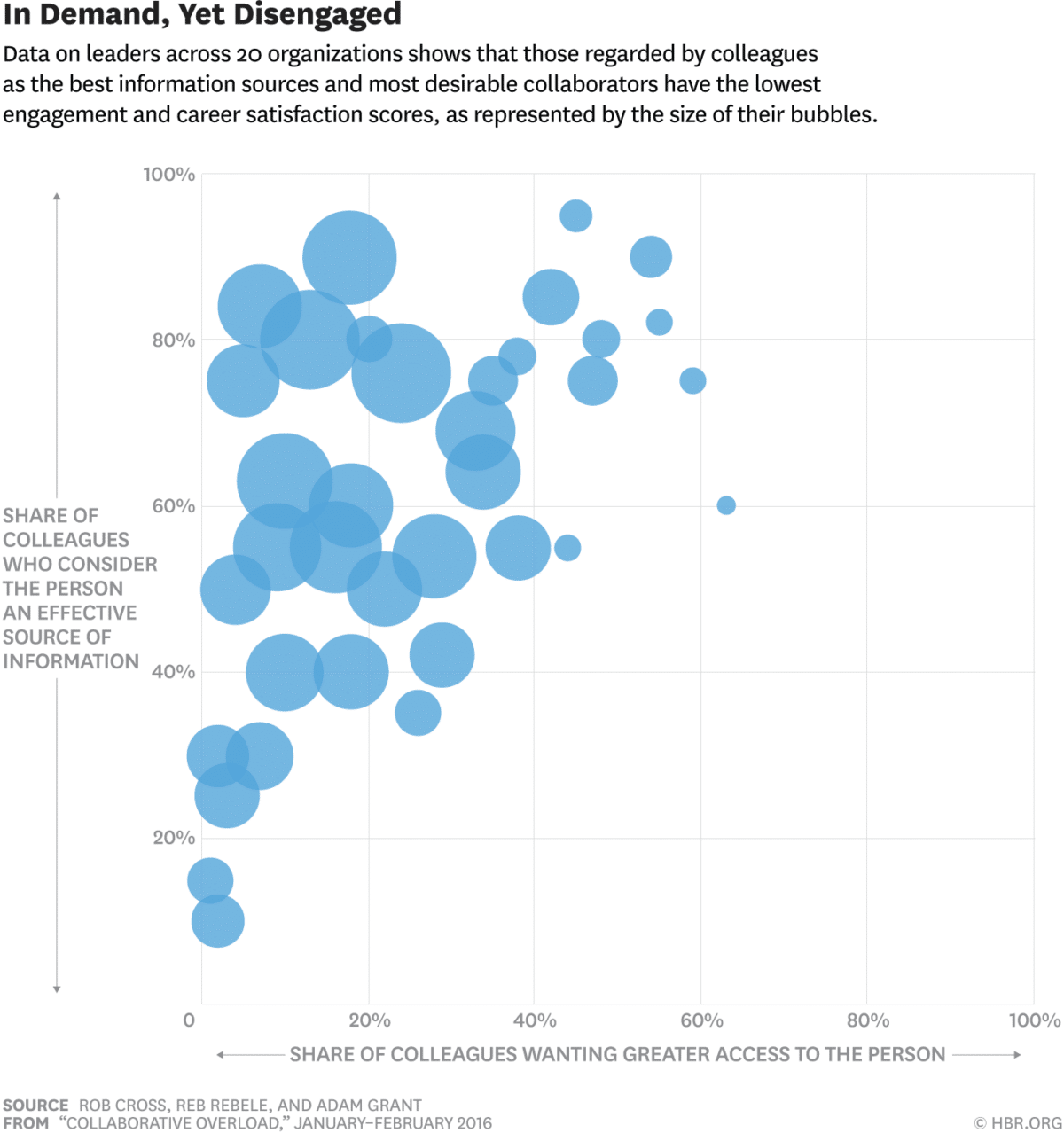
Image Source: Harvard Business Review
The truth is, we could go hours talking about the pros and cons of online and offline communication.
These might both be convenient, depending on the work environment and tasks that one needs to complete.
However, when it comes to asynchronous communication and its opposite, we think that asynchronous communication can help minimize distractions as well as reduce multitasking.
Additionally, it’s definitely less stressful!
To sum this tip up, having to perform while keeping an eye on Gmail can have a negative impact on one’s productivity so make sure you’re saving your energy for the tasks that actually require it.
Tip #6: Don’t Start Your Day By Replying to Emails
A rather useful piece of advice when it comes to being productive throughout your workday is to avoid starting your day by replying to emails.
On the contrary, you should be trying to start your workday doing some efficient and productive work.
This tip is firmly linked to two other tips presented in this list of productivity tips.
More specifically, it falls both under the “stay away from distractions” as well as the “use your productive hours wisely” banners.
During our first working hours, we all tend to be more productive and focused.
That happens because we’re more likely to be well-rested after a good night sleep or our destress morning workout routine.
For that reason, it makes sense that we reserve these first working hours for performing productive and difficult tasks rather than wasting them on unproductive tasks, like replying to emails.
Tip #7: Use the Right Collaboration Tools
Our seventh productivity tip to help you get the most out of your day is to use the right collaboration tools.
I can’t stress this enough!
Trust me when I say that collaboration tools allow you to perform in the best way possible.
They’re kind of your allies in getting things done in the right amount of time while also helping you to keep your virtual workspace organized.
Additionally, the right collaboration tools can help you save time, become better and more efficient, and ultimately, produce work of high quality.
Modern collaboration tools like Mindomo can make a huge difference in the way you perform collaborative processes, like brainstorming and project planning.
Visualizations like mind maps and Gantt charts are definitely some of the most useful visuals you can create in order to collaborate in a better and more efficient way. Moreover, you can create a mind map online collaborating with your team members and you can access it from any device, anywhere you are. This way you can edit it easily and fast, keeping your team updated. If mind mapping is a new concept for you, you can learn more about what is a mind map and how to use it for work, personal life, and even for study.
Furthermore, a design tool like Visme can also help you elevate your performance in terms of collaboration.
How?
Well, by allowing you to create all sorts of compelling content that can be shared within your team and reviewed by the team members.
These might be videos or engaging presentations that can truly enhance the way you work together.
Tip #8: Give Your Mind a Break
Last but not least, one of the best productivity tips we can give you is to always give yourself and your mind a well-deserved break.
Everyone needs a break and there’s no human being that can be productive all day long.
Giving your mind a break by taking a walk, doing some exercise, taking a power nap, or meditating can enhance your productivity and prevent you from experiencing an overload of work burnout.
In fact, taking short breaks is considered one of the top things that can boost productivity.
Have a look at the infographic below:
Image Source: Get Hppy
There are lots of techniques out there that basically help you keep track of the time you’ve been working.
You might consider using a time management technique, like the Pomodoro Technique, which is one of the most popular.
Or you might prefer using a time tracking app.
Whatever you do, remember that relaxed minds are more likely to perform better and be more productive.
Make sure you take all the short breaks your mind and body need.
Now Over to You
There you have it.
Our list of eight productivity tips that’ll help you get things done and get the most out of your workday is completed.
In this post, we talked about the importance of setting goals and doing some proper planning during your workday.
Additionally, we discussed how breaks and asynchronous communication can significantly improve your productivity.
Last but not least, keep in mind that collaboration tools can help a great deal of stress in terms of planning from your shoulders.
We hope you’ll follow our productivity tips and get the most out of your day!
Author:
Payman Taei is a UI/UX designer and the founder of Visme, an all-in-one visual communication platform empowering everyone to create and share beautiful interactive presentations, infographics, and other forms of engaging content with no design skills. He is also the co-founder of Respona, the all-in-one PR, and link-building tool that combines personalization with productivity.


